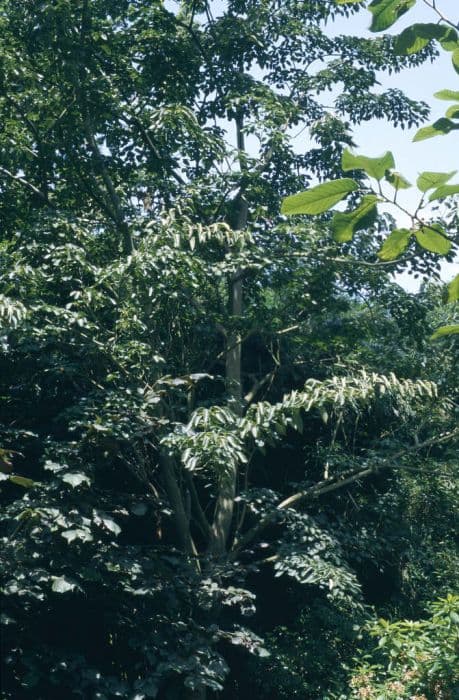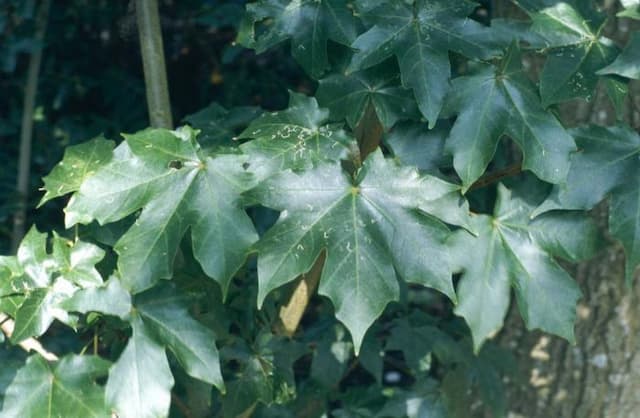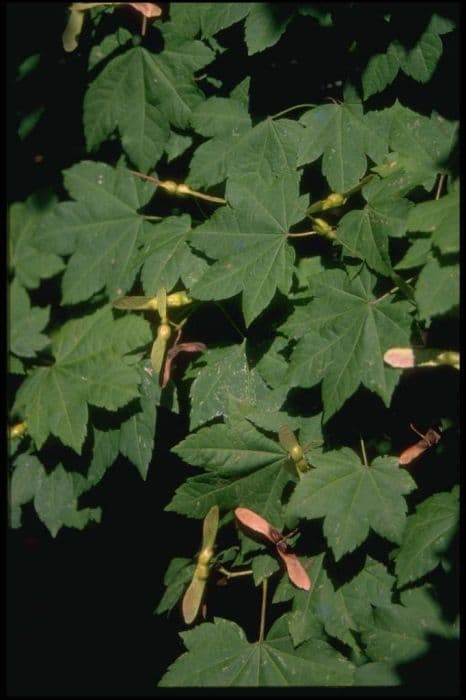Japanese Maple Acer palmatum 'Beni-kagami' (M)

ABOUT
The Japanese maple 'Beni-kagami' is a beautiful ornamental plant known for its stunning foliage and elegant growth habit. The leaves of this cultivar are its most striking feature; they are palmate, which means they have multiple lobes spreading outward in a shape that resembles an open hand. Each leaf is intricately cut with a delicate structure, providing a lace-like appearance that adds a sophisticated touch to the plant. In spring, the foliage emerges with a vibrant red-purple color that commands attention in any garden setting. The leaves are not uniformly colored but rather show a mix of deep purples and reds, sometimes edged with brighter red hues that create a dazzling display. As the seasons progress, the leaves undergo a transformation, with the red-purple coloration deepening and sometimes developing tones of dark green, depending on the light exposure and other environmental factors. During the fall, the leaves put on another spectacular show, transitioning to a range of colors from bright red to a fiery crimson. This seasonal change underscores the dynamism of the Japanese maple 'Beni-kagami,' making it a focal point of the landscape throughout the year. The overall shape of the Japanese maple 'Beni-kagami' is balanced and pleasing to the eye, with branches that spread out gracefully to form a rounded canopy. The branching pattern provides a visual interest even in the winter months when the tree is devoid of leaves. The bark and branches have an attractive texture that adds to the winter landscape. Overall, the Japanese maple 'Beni-kagami' is a true gem in the garden, offering a burst of color and elegance with its unique, seasonally-changing foliage and attractive growth form. Its ornamental value makes it a beloved choice for gardeners seeking to add a touch of drama and sophistication to their outdoor spaces.
About this plant
 Names
NamesFamily
Sapindaceae
Synonyms
Japanese Maple, Red Japanese Maple, Beni-kagami Japanese Maple
Common names
Acer palmatum 'Beni-kagami'
 Toxicity
ToxicityTo humans
Japanese maple, the common name for Acer palmatum 'Beni-kagami', is not known to be toxic to humans. This ornamental plant is primarily grown for its attractive foliage and is generally considered safe. There are no commonly reported symptoms of poisoning from ingesting parts of this plant. However, as with any non-food plants, caution should be taken to avoid ingestion as individual allergies or adverse reactions could occur.
To pets
Japanese maple, the common name for Acer palmatum 'Beni-kagami', is considered to be non-toxic to pets such as dogs and cats. It is commonly used in landscaping and poses minimal risk if pets come into contact with it or ingest its leaves. There are no specific symptoms of poisoning associated with this plant since it is not known to be poisonous to animals. However, pets should not be encouraged to eat ornamental plants as they could cause stomach upset or other non-toxic reactions.
 Characteristics
CharacteristicsLife cycle
Perennials
Foliage type
Deciduous
Color of leaves
Varies
Height
6 feet (1.8 meters)
Spread
5 feet (1.5 meters)
Plant type
Tree
Hardiness zones
5
Native area
Japan
Benefits
 General Benefits
General Benefits- Ornamental Appeal: The Japanese Maple is known for its aesthetic beauty with deep red foliage providing a stunning display in gardens and landscapes.
- Seasonal Interest: Its leaves change color throughout the seasons, offering a dynamic range of visuals from spring through fall.
- Shade Provider: Mature trees can offer a cool, shaded area in gardens during the warmer months, making outdoor spaces more comfortable.
- Wildlife Habitat: Japanese Maples can provide shelter and food for birds and other wildlife, supporting local biodiversity.
- Compact Size: As a relatively small tree, it is suitable for smaller gardens and spaces where larger trees might not be appropriate.
- Low Maintenance: Typically requires minimal pruning and can thrive without extensive care once established, which is ideal for gardening enthusiasts of all levels.
- Versatile Landscaping: Can be used in a variety of landscape designs, including traditional Japanese gardens, modern minimalist settings, or as a focal point in mixed borders.
 Medical Properties
Medical PropertiesThis plant is not used for medical purposes.
 Air-purifying Qualities
Air-purifying QualitiesThis plant is not specifically known for air purifying qualities.
 Other Uses
Other Uses- Acer palmatum 'Beni-kagami' can be used as a natural dye, producing a range of colors from the leaves, especially in autumn when they turn bright red.
- In bonsai culture, this variety of Japanese maple is highly appreciated for its aesthetic qualities and used to create miniature landscapes.
- The wood of the Japanese maple can be used for making small artifacts, like handles for tools and intricate woodworking projects due to its fine grain.
- Leaves of the Acer palmatum 'Beni-kagami' are used in traditional Japanese ceremonies for decorations due to their striking color.
- Photographers and artists often use this plant as a subject or backdrop for its vivid foliage and ornamental appeal.
- In interior design, branches of the 'Beni-kagami' Japanese maple are used in floral arrangements to add a touch of natural elegance.
- For educational purposes, this plant is used to teach about plant physiology, especially the process of photosynthesis and color change in foliage.
- During fall festivals in Japan, leaves from the Japanese maple are sometimes floated on water in decorative bowls as part of the seasonal aesthetics.
- The plant can be used in landscape photography workshops, where participants learn about composition and color balance using its vibrant foliage.
- Gardeners practice the art of 'momijigari' or red leaf hunting with this variety due to its stunning autumnal hues, a traditional Japanese activity similar to cherry blossom viewing.
Interesting Facts
 Feng Shui
Feng ShuiThe Japanese Maple is not used in Feng Shui practice.
 Zodiac Sign Compitability
Zodiac Sign CompitabilityThe Japanese Maple is not used in astrology practice.
 Plant Symbolism
Plant Symbolism- Beauty and Elegance: The Acer palmatum 'Beni-kagami', commonly known as Japanese Maple, often symbolizes beauty and elegance due to its delicate leaves and striking color, particularly the red tones of the 'Beni-kagami' cultivar that suggest a refined and aesthetic quality.
- Peace: Japanese Maple is associated with peace and calm, which may derive from its common use in traditional Japanese Zen gardens where it is meant to inspire tranquility and contemplation.
- Balance: With its balance between graceful form and strength, the Japanese Maple can symbolize the balance in nature and within ourselves, resonating with a harmony of opposites.
- Endurance and Change: As a species that experiences dramatic changes in appearance with the seasons, the Japanese Maple is emblematic of endurance and embracing change, showing how transition can bring its own form of beauty.
 Water
WaterJapanese Maples, including the 'Beni-kagami', should be watered deeply but infrequently, allowing the soil to slightly dry out between waterings. On average, this means watering once a week, but this can vary depending on climate conditions and soil type. During hot, dry spells, you might need to water more often, like every 2-3 days. It's best to provide about 2 gallons of water for a small or medium-sized tree during each watering session. Always avoid overhead watering to prevent leaf scorch and water directly at the base of the plant.
 Light
LightJapanese Maples, such as the 'Beni-kagami', thrive best in partial shade to full sun, with preference for the former to protect their delicate foliage. An ideal spot would be one where the tree is shielded from the harsh afternoon sun, which can damage the leaves. Morning sunlight with afternoon shade or filtered sunlight throughout the day is optimal for the health and coloration of its leaves.
 Temperature
TemperatureJapanese Maples like 'Beni-kagami' prefer temperate climates and do best when the temperature is consistently between 60 and 80 degrees Fahrenheit. They can survive in temperatures as low as -20 degrees Fahrenheit during dormancy in winter and can tolerate summer heat as long as they are not in direct afternoon sun. Ideal growing conditions involve avoiding dramatic temperature swings and providing protection from cold winds.
 Pruning
PruningPrune the Japanese Maple 'Beni-kagami' to maintain its shape, encourage healthy growth, and remove any dead or diseased branches. The best time for pruning is late winter or early spring before new growth starts but after the threat of intense cold has passed. Pruning can be done annually, focusing on light thinning to enhance the tree's natural form rather than heavy cutting back.
 Cleaning
CleaningAs needed
 Soil
SoilJapanese Maple 'Beni-kagami' thrives best in well-draining soil rich in organic matter, with a pH between 5.5 to 6.5. A mix of loamy soil, peat moss, and perlite can create an ideal environment for root growth and health.
 Repotting
RepottingJapanese Maple 'Beni-kagami' should be repotted every 2-3 years, ideally during late winter or early spring when the tree is dormant. Younger trees may require more frequent repotting.
 Humidity & Misting
Humidity & MistingJapanese Maple 'Beni-kagami' prefers moderate humidity levels but is adaptable to various conditions. Avoid overly dry environments to reduce stress on the tree.
 Suitable locations
Suitable locationsIndoor
Place in bright, indirect light with some direct sun.
Outdoor
Provide partial shade, shelter from harsh winds.
Hardiness zone
5-9 USDA
 Life cycle
Life cycleThe Japanese Maple 'Beni-kagami' begins its life as a seed, which after stratification, will germinate in the favorable conditions of spring. As a seedling, it quickly develops a taproot and begins to produce its characteristic leaves, entering a juvenile phase where growth is rapid. As the tree matures, it slows its growth rate and begins to develop its adult structure with the development of branches and deep burgundy-red leaves. During each growing season, it will produce new foliage and may flower, producing inconspicuous red to purple flowers followed by samaras, or winged seeds. Throughout its adult life, which can last for decades, it undergoes annual cycles of growth in the spring and summer, and dormancy in the fall and winter when it sheds leaves. The tree reaches its natural end of life due to old age or environmental factors, at which point it may become a source of seeds for new trees or decompose and contribute to the soil nutrient cycle.
 Propogation
PropogationPropogation time
Late winter
The Red Japanese Maple 'Beni-kagami' is generally propagated through grafting, a popular method that is best performed in late winter to early spring before bud break. Grafting involves taking a scion, a short piece of stem with two or more buds, from the 'Beni-kagami' maple and joining it to a rootstock of another maple species. The scion is commonly grafted onto the rootstock using a technique called bench grafting where a diagonal cut is made in both the scion and the rootstock to match and maximize the cambium layers' contact. These cuts are made with a sterile, sharp grafting knife to ensure a clean connection. The grafted area is then securely wrapped with grafting tape and covered with a grafting wax or sealant to prevent dehydration and disease entry. Once the graft has taken, which can be verified by the growth of new shoots, the tape can be removed, and the young tree is allowed to grow in a controlled environment before being planted out.





![Freeman maple [Autumn Blaze]](/_next/image?url=https%3A%2F%2Fplants-admin.emdemapps.com%2Fimages%2Fplants%2F%2Fimages%2F604b575b84d87.png&w=640&q=75)



